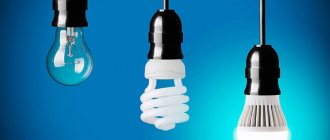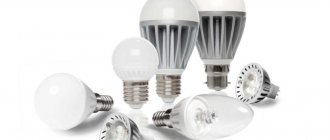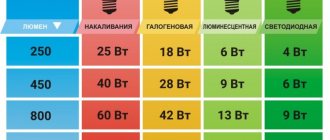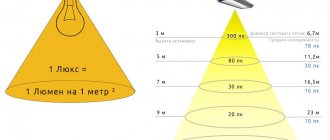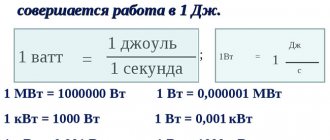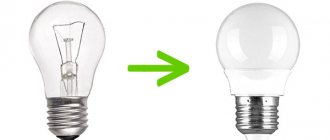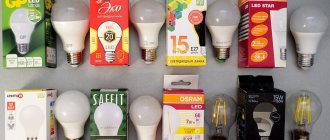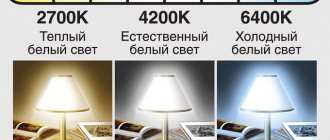Incandescent lamps have been used by people for more than a hundred years as the main lighting device for their homes, city streets, workplaces and other things.
For so long, lighting technologies have developed sluggishly, fluorescent and so-called energy-saving light bulbs have appeared, but LED lighting technology has become a new technology.
One of the most important parameters of any lighting device is the power of the luminous flux, and this article is devoted to it. Later in the article we will look at the lamp luminous flux table.
What is luminous flux
In fact, to calculate illumination, designers previously used another value - candela (candle), which also has a direct correspondence to the watts consumed by an incandescent lamp. In the technical literature of the beginning of the second half of the last century one can find the expressions “thousand-candle lamp”, etc. Brightness in candelas refers to the power of light in watts emitted in a particular direction. As a visual association, such brightness is provided by an ordinary burning paraffin or stearin candle. Hence the name. This approach provides a visual representation of brightness as the number of candles burning.
The brightness of the glow is one candela
Important! The watts used to calculate candelas are not related to electrical power - the light source may not be electric (the same candle).
There is a definition for the concept of luminous flux - the power of radiation energy, which is assessed by the sensation of light. Or the number of photons emitted per unit time. Mathematically, it looks like this: if a point source with an intensity of 1 candela emits a flux into a solid angle equal to one steradian, then it creates a luminous flux of 1 lumen (lm).
Graphic representation of the steradian
The concept of steradian requires clarification. To represent a solid angle of 1 sr, you need to take a cone with a vertex at the center of a sphere of radius R, which cuts out an area equal to R2 on the surface of the sphere. The opening angle of such a cone is about 65 degrees.
If a point source of light of 1 candela, emitting equally in all directions, is placed in a sphere with a radius of 1 m, then an illumination equal to 1 lux (lx) will be created on its inner surface. This value is used to set lighting standards. Thus, for various premises, according to SNiP, the following conditions must be met:
- classrooms of secondary schools – 500 lux;
- university audiences – 400 lux;
- gyms – 200 lux.
Lighting standards have also been established for other rooms.
If a luminous flux of 1 lm falls on 1 sq.m. surface, it creates an illumination of 1 lux. Hence the connection between lumen and lux: 1 lux = 1 lm/sq.m. For example, to provide sufficient illumination in a classroom of 100 square meters, a luminous flux of 40,000 lumens is needed. It is also necessary to take into account that illumination decreases in proportion to the square of the distance from the light source, so the height of the lamp suspension matters.
Selection by technical parameters
When choosing an LED lamp for an apartment or house, you must start with the technical characteristics. It was incandescent lamps that only had power, and also the size of the base.
The LED lamp consists of several devices
LED lamps are more serious equipment, in which, in addition to the crystal that emits light, there is also a built-in voltage converter - a driver that transforms alternating mains voltage into 12 volts direct current. So to make the right choice you will have to familiarize yourself with some technical nuances.
Power and luminous flux
Power is measured in watts. Abbreviated in Russian as “W”, in English it is designated by the letter W. It is this value that has traditionally been used to determine the luminous efficiency of incandescent lamps. And so it continues, although modern lighting devices have many times lower ratings and produce the same amount of light. This is what we will look into.
It's not all rosy when it comes to savings, but bills are getting significantly smaller.
At the current stage of technology development, LED lamps are considered the most economical: while consuming a minimum amount of electricity, they produce a greater amount of light. If we compare them with incandescent lamps, they are almost 10 times more efficient. This means that where there used to be a 100-watt Ilyich lamp, you need to install a 9-10 W LED lamp. A good way to significantly reduce your electricity bills. To make it easier to choose an LED lamp by power, there is a table corresponding to the power of different types of light sources.
| Incandescent lamps | Luminescent and energy saving | LED | Light flow |
| 20 W | 5-7 W | 2-3 W | 250 lm |
| 40 W | 10-13 W | 4-5 W | 400 lm |
| 60 W | 15-16 W | 6-10 W | 700 lm |
| 75 W | 18-20 W | 10-12 W | 900 lm |
| 100 W | 25-30 W | 12-15 W | 1200 lm |
| 150 W | 40-50 W | 18-20 W | 1800 lm |
| 200 W | 60-80 W | 25-30W | 2500 lm |
Today there are different types of lamps in stores - incandescent, halogen, energy-saving, LED. They all have different effectiveness. And if you don’t have a correspondence table at hand, you can focus on the luminous flux created by the lamp. You can take the same incandescent lamps as a basis - we are used to them, we have been using them for a long time and have a good idea of how much light a 100 W lamp, for example, gives. So, this lamp produces about 1200 lm. By remembering this figure, you can more or less accurately imagine what luminous flux the lamp you are considering produces, since most packages contain Lums, which display the amount of light that a given source emits.
Colorful temperature
You've probably noticed that light from artificial sources has different colors. This is the color temperature of light. LEDs have an extremely wide emission range - they can be colored - green, red, blue, or produce violet light. This feature is used if color illumination is needed.
And these are all shades of white
When choosing LED lamps for lighting a house or apartment, only a small part of the spectrum is considered. But there is a lot of choice here too. LEDs recreate many shades of light - from that produced by the bright midday sun, to the muted yellowish or slightly reddish tint of the sun at sunset or dawn.
| Colorful temperature | Hue | Characteristics and scope |
| 2700 K | Warm white with a reddish tint | This light is emitted by incandescent lamps of not very high power. Feeling of warmth and comfort. |
| 3000 K | Warm white with a yellowish tint | Characteristic of halogen lamps, the light is slightly cooler. |
| 3500 K | Regular white or neutral white | Characteristic of fluorescent lamps. Neutral light that does not distort color perception. |
| 4000 K | Cold white | Used in some modern styles - high-tech, for example. It can tire you with its “sterility”. |
| 5000-6000 K | Daylight | Used for lighting greenhouses. Too bright for home lighting. |
| 6500 K | Cold daytime, has a bluish tint | Very bright. Used for photo and video shooting. |
It is worth choosing an LED lamp based on color temperature based on the purpose of the room. For overhead lighting in the bedroom, it makes sense to choose a warm white color with a yellowish, or better yet, reddish tint. It promotes relaxation more than others.
This is how you can display the difference in color temperature
At the same time, reading lamps - sconces or table lamps - should be equipped with lamps with neutral white light. We recommend using them in all other rooms. Despite the fact that yellowish light is more familiar to us, with neutral white you will feel better - it’s easier to read, your eyes will tire less. These are subjective feelings based on personal experience.
Color rendition
Having lamps of the same color temperature we can get different color perceptions. This depends on the accuracy of color rendering, which is characterized by the color rendering index (coefficient). It is denoted by the Latin letters CRI (Color Rendering Index), followed by numbers from 0 to 100. Sometimes denoted as Ra.
| Color rendering characteristics | Color rendering degree | Color rendering index CRI | Examples of lamps |
| Very good | 1 A | More than 90 | LED and halogen lamps, fluorescent lamps Philips TL-D 90 Graphica Pro, OSRAM DE LUXE and Color proof |
| Very good | 1 B | 80-89 | LED and fluorescent lamps (OSRAM LUMILUX, VANTEX, LDC, LBTC) |
| good | 2 A | 70-79 | Fluorescent lamps OSRAM BASIC |
| good | 2 B | 60-69 | Fluorescent lamps LD, LB |
| Sufficient | 3 | 40-59 | Mercury vapor lamps |
| Low | 4 | 39 and less | Sodium |
The highest value is 100. A light source with this color rendering coefficient does not distort colors at all, but the cost of such a lamp will be very high. For home lighting, lamps with a CRI of 80 and above are considered normal. It is in this range that you should look for LED lamps for home lighting. And again, you will have to select depending on the purpose of the lamp. For example, when lighting paintings, it is advisable to use lamps with a color rendering index of 100 or so, as they will not distort colors. For other premises it is possible with lower values.
Scattering angle
The distinctive feature of LEDs is that they shine directly in front of you. A very small amount of light waves are deflected to the sides. That is, the crystal itself produces a narrowly directed beam of light. But an LED lamp contains a certain amount of these crystals. The angle of light scattering depends on how they are located. This allows you to create both a very narrow stream of light and a very wide one. The scattering angle of LED lamps can be from 30° to 360°.
This makes it easier to understand what the light scattering angle is
It is also necessary to select the scattering angle of the LED lamp based on the purpose of the lamp. If this is a general lighting lamp placed on the ceiling, the dispersion angle should be taken from 90° or more - up to 180 degrees. If this is a reading lamp or for illuminating a small area (for illuminating paintings, for example), you should choose a more narrowly focused beam.
In decorative lamps with slots, it is worth installing a lamp with a scattering angle of 360° or install narrowly directed ones. You can get a very interesting effect.
Examples of using LED lamps with different beam angles
If you haven’t been able to create a similar play of shadows before, now you know that you need to choose the right LED lamp.
Type of base and presence of radiator
The base can be selected simply: to match the existing lamp. The industry produces LED lamps with standard sockets for replacing incandescent lamps (E14, E 27, E40); there are options for replacing halogen lamps (G4, GU5.3, GU10). There are LED lamps that are built into furniture to illuminate cabinets and cupboards. They have a base type GX53.
Table of images of caps and their names
One of the disadvantages of LEDs is that they heat up, and when the temperature increases significantly, they lose their brightness. If they overheat too much, they may even fail. There are two designs of LED lamps - in the form of the usual bulb and without it - the so-called corn lamp. To better remove heat from the crystals, radiators are usually installed in bulb lamps. In corn, due to the absence of a flask, heat removal occurs efficiently and without a radiator.
There are several types of radiators for LED lamps with bulbs:
- Ribbed aluminum. Copes well with heat removal due to ribbing, which increases the heat transfer area. But aluminum conducts current well, to protect against dangerous contact; the surface of the radiator is usually covered with paint or varnish.
Finned aluminum radiator is easy to distinguish - Smooth aluminum. This is usually a thin layer of aluminum. Heat dissipation is usually poorer; there may be holes for better ventilation.
A smooth aluminum radiator for LED lamps is coated with varnish or paint - Ceramic. The most effective way to remove heat, but such LED lamps are the most expensive. Ceramic does not conduct current, so LEDs are often mounted directly on the radiator, which promotes more efficient cooling.
Ceramics dissipate heat most efficiently - Composite. This is an aluminum radiator, on top of which a layer of heat-conducting plastic is applied. This type of radiator is widespread, since it has a low price, with good heat dissipation and safety. Accordingly, LED lamps with composite radiators are in the middle or low price segment.
Composite - medium and low price range - Plastic. Special plastic is used that conducts heat well. This is the most inexpensive option for radiators for LED lamps, which has average efficiency. To improve heat dissipation, there may be holes.
You shouldn’t choose a cheap LED lamp and hope that it has a ceramic radiator installed. But plastic coolers are also scary. They have a more than decent service life and will recoup the money spent on their purchase many times over.
Lamps with ceramic or corrugated aluminum radiators should be installed in places where heat dissipation is critical. For example, in built-in lamps in which the hottest back part of the lamp is at the level of a suspended ceiling or furniture board/wood/fibreboard. Here, strong heating can lead to changes in the structure and color of the material, which is clearly not good. In less critical situations, even plastic and composite radiators work normally - LED lamps still heat up several times less than incandescent lamps.
Working life and warranty period
One of the most important parameters for consumers is working resource. It is indicated in hours and shows how long the LED lamp remains operational (under normal operating conditions). The average “life expectancy” of modern LED lamps is about 30,000 hours, which is equivalent to 10 years, the maximum is about 50-60 thousand, which is about 15-18 years. But LED technology is actively developing and, most likely, LED lamps with a working life of 100,000 hours or even more will appear in the near future.
The data is very different
But don’t delude yourself too much. The working life is the time that the crystal is capable of emitting light. Unfortunately, there is such a thing as LED burnout. As a result of this phenomenon, they lose their brightness. The speed of these changes depends on the operating conditions - the less the LED overheats and the less it is exposed to low temperatures, the longer the original brightness is maintained. How do you know how long a lamp will last without losing brightness? According to the warranty period. This figure more realistically reflects the state of affairs, since in case of problems the device is simply replaced with a new one. Here, manufacturers, on the contrary, tend to slightly underestimate the figure so that there are as few warranty cases as possible.
Dimming
You can change the brightness of the lighting in a room in two ways - by increasing or decreasing the number of switched on lighting fixtures or by installing a brightness control - a dimmer. The second method is more convenient, as it allows you to precisely “tune” the lighting to your requirements by smoothly changing the brightness of the glow by turning the knob.
To choose an LED lamp to connect with a dimmer, look for the dimming limit in the specifications
But, if you need to choose an LED lamp for a network with a dimmer, the technical specifications should indicate that it is dimmable. The usual one will shine at full strength, but at a certain position of the dimmer it will simply start blinking.
In addition to the fact that the lamp must be dimmable, you need to look at the dimming limit. Some have a minimum dimming limit of 5%, others 20%.
Principle of operation
To understand the convenience of using all these quantities, we need to consider the direction of LED emission, and related concepts.
Angles of LED illumination with lens
The design of the light-emitting diode is such that it does not send light evenly in all directions - the lower hemisphere is covered by a substrate, and the design of the lens is such that it does not provide uniform radiation in the upper hemisphere. As a result, the main light flux is concentrated in the upper direction and weakens towards the periphery of the light cone. At a certain viewing angle, the intensity of the glow is reduced by half, and when an even greater angle is reached, the light becomes invisible. The first angle (bac) is called the half brightness angle, and the second (fah) is called the full brightness angle.
Luminous angles of an LED with phosphor
The same points apply to an LED with a phosphor. There, the radiation angle is limited by the substrate and the angle of greatest activity of the initiating radiation of the pn junction. You must understand that it is impossible to accurately determine these angles by eye - special instruments are needed. But you can visually compare two LEDs - which one has a larger opening angle.
What does it depend on
Theoretically, it is believed that this data should only affect the light source itself and in no way affect the entire luminaire.
However, practice shows that a huge contribution to the final result of the light output is made by:
- different reflectors
- diffuser shape
- driver
- LED temperature mode
- even measurement conditions
Therefore, it would be more correct to call this term “light output of the lamp.” When purchasing, always ask for this parameter, i.e. what is the output of the lamp assembly, and not of its LEDs inside.
Luminous output of LED lamps
The light output of LED lamps does not depend on the degree of heating of the crystal. Almost all white illuminators are made on the basis of LEDs with a phosphor, so the luminous efficiency depends on the quality of this phosphor and the technology by which it is produced. Also important is the light emission of the initiating crystal and the ability of this radiation to cause the glow of the phosphor in the visible part of the spectrum.
Powerful white LED with phosphor
Extra options
Product service life
Service life is a very abstract characteristic of an LED lamp. The fact is that by service life the manufacturer understands the total operating time of the LEDs, not the lamp. At the same time, the mean time between failures of the remaining parts of the circuit remains in great doubt. In addition, the operating time is affected by the quality of the housing assembly and soldering of radio elements. In addition, more than one manufacturer, due to its long service life, does not conduct full tests on the degradation of LEDs in the lamp. So the declared 30 thousand hours or more is a theoretical indicator, and not a real parameter.
Flask type
Despite the fact that the type of flask is not a critical technical parameter for many, in many models it is indicated in the first line. Typically, the type and marking of the flask is expressed in a alphanumeric code.
Weight
Rarely is anyone interested in the weight of a product at the time of purchase, but for some lightweight lamps it matters.
Dimensions
There are as many cases as there are manufacturers, differing in appearance and dimensions. For example, 10 W LED lamps from different manufacturers may differ in length and width by more than 1 cm. When choosing a new LED lamp for lighting, do not forget that it must fit into an existing lamp.
The market for LED products continues to develop dynamically, as a result of which the characteristics of lamps change and improve. We hope that in the near future quality standards will be developed for LED lamps that will make it easier for the buyer to make a choice. In the meantime, your own knowledge is the main support when choosing and purchasing.
Luminous flux of outdoor lighting
To calculate outdoor lighting, one must proceed from the minimum illumination standards, which can also be found in the relevant SNiP (SP). So, for children's playgrounds, the minimum illumination should not be less than 10 lux.
The standards give minimum illumination values; they can be increased during calculations.
To obtain the required number of lamps (N) to obtain the required illumination, you need to set the initial data:
- minimum illumination (E), lux;
- area (S), sq.m.;
- illumination unevenness coefficient (z), for LED lamps it is equal to 1.2;
- a multiplier that takes into account the weakening of the luminous flux at the end of the lamp's service life (k), for LED devices it is equal to 1.2;
- luminous flux of one lamp (F), lm;
- the coefficient for taking into account the reflection of objects located nearby (n), for asphalt it can be taken as 0.3.
These quantities are related by the formula N=E*S*z*k/(F*n).
Playground lighting
Suppose you need to illuminate a children's playground with an area of 150 sq.m. There are lamps emitting a luminous flux of 1500 lm each. Substituting the values into the formula, we get N=10*150*1.2*1.2/(1500*0.3). You will get 4,8 or 5 lamps. This is the minimum quantity; in fact, more can be installed.
You can ask not the luminous flux of the existing lamps, but the number of lamps that can be installed on the territory. In this case, it is necessary to calculate the luminous flux of each lamp. The calculation formula will take the form F=E*S*k*z/(N*n). If the final result does not fall into the standard range of lamp characteristics, it must be rounded up.
Summing up
The power of the LED lamp, when choosing, is not a paramount value. Much more important is the luminous flux it emits. The same point applies to energy-saving CFLs. If we take a more pedantic approach to replacing burnt-out artificial light sources with LED analogues, then in addition to comparing light fluxes, it is necessary to take into account the pulsation coefficient, color rendering index and a number of other points, described in detail in the article on choosing LED lamps. It is also recommended to pay attention to the design features of the lamp in which the light bulb will be used.
The relationship between lumens and watts
Consumers around the world, over decades of incandescent lamp dominance, have become accustomed to relating lighting brightness to electrical power consumption. For these outdated devices, this was reasonable - the development of technology in this direction had long ago reached a dead end. The ratio of power and lighting intensity has become established and has become a habit.
For LED lighting, there is no direct relationship between the power consumption in watts and the luminous flux produced in lumens . More precisely, it exists, but only for the current moment. Technologies do not stand still, the production of crystals is being improved, and new phosphors with increased light output are being developed. The relations of the present tense will tomorrow turn out to be hopelessly outdated.
Maximum light output
What is the maximum possible light output under ideal conditions? In theory, it reaches 683 Lumens/watt.
But this is only possible at a wavelength of 555nm (green).
Our retina contains about seven million receptors - red, blue and green. More than half of them are green. Therefore, we perceive green as the brightest color.
Many people are mistaken in believing that it is enough to pass max current through the LED crystal, and thus the maximum light output value will be achieved. This is wrong.
For this, a sufficient current is required, ranging from thirty to sixty percent of its maximum values.
Therefore, LEDs should ideally be underloaded.
Real measurements of cheap LEDs with small crystals clearly show that using more than 30% of them is not rational.
As a result, with less load you get:
- longer service life
- lower heating temperature
- highest light output
However, there is one negative point - you will need more of them. And this will increase the cost of the product.
Light brightness table
Currently, the correspondence between the luminous flux of modern LED lamps and their power consumption looks like this:
| Luminous flux, lm | 250 | 400 | 650 | 1300 | 2100 |
| LED lamp power consumption, W | 2-3 | 5-7 | 8-9 | 14-15 | 22-27 |
| Equivalent incandescent lamp power, W | 25 | 40 | 60 | 100 | 150 |
The table shows approximate rounded values, since the lamps on the market have been produced over several years by different manufacturers using different technologies. For perception “by eye” this scatter is practically not noticeable.
In conclusion, the video: The difference and relationship between watts, lumens and kelvins.
Having a clear understanding of the relationship between the characteristics of light radiation, you can independently calculate the lighting of a room or area. To do this, you need to know the lighting standards and technical characteristics of LED lamps.
Design: base and bulb
Structurally, the LED lamp consists of:
- printed circuit board with a driver for converting alternating current into direct current;
- light source - one or more LEDs;
- diffuser bulbs designed for uniform light dispersion;
- base and housing.
Plus, there is a small radiator inside that dissipates the thermal energy generated when the LED crystal glows. Although it is formed a little, it is still there.
Of all these elements, only the shape of the bulb and the type of base may be of interest to the buyer of an LED lamp. The remaining details are not even described in the markings and data sheets of such light bulbs.
LED lamps are now available with all types of bases (threaded, pin, soffit, etc.) - this is specially done for their wider distribution and easy replacement of old analogues (+)
Most often, at home, LED lamps are used with standard threaded sockets.
They have the letter “E” in their designation and a number indicating the diameter size. The typical option is an E27 base, similar to a regular household lamp with a 60, 80 or 100 W filament.
In homes you can also find light bulbs with E14 minion sockets (“candles” for sconces).
The bulb shape of an LED lamp can be anything from classic pear-shaped to twisted and tubular - for each lighting project there is the most suitable option
Models with a G or GU pin base are designed to replace halogen counterparts. And GX are small flat lamps for recessed lighting. They are mounted in furniture walls and ceilings.
Housing designs also differ in IP protection level. In dry rooms without much dust (for example, corridors and bedrooms of apartments), IP20 or IP21 will be sufficient. For installation in kitchens, bathrooms or garages, a lamp should be selected with IP56 or higher. And only models with at least IP65 are suitable for outdoor use.
Distribution of lamps among rooms
Now let's put all the information together and determine the right amount of light in each room. Let's take the value in lumens (lm) as a basis. Depending on your preferences and the size of the room, the numbers can be changed by +- 20 %.
To liven up the atmosphere of your home, consider increasing the total lighting area. The main sources are recessed ceiling lights. Additional - sconces, chandeliers and others.
At the end of this section, there is a mathematical formula to help determine how many lumens LED bulbs should emit in each room.
Kitchens and bathrooms. Maximum brightness
Use - need a lot of light:
- Brightness : bathroom - at least 4000 lm, in kitchens - from 5000 to 10000 lm.
- Temperature : high value - 5000 - 6000 kelvin, energetic light.
- Add-ons : light strips or spotlights.
Dining rooms and offices. Average brightness
Use - solving specific problems:
- Brightness : 3000 to 6000 lumens per room.
- Temperature : Center LEDs with values of 4000 - 4500 Kelvin for pleasant, balanced lighting.
- Additions : table lamps, floor lamps, light strips, directional lamps.
Bedrooms and living rooms. Minimum brightness
Use - rest, relaxation:
- Brightness : living room - 1500 - 3000 lm, bedrooms - from 2000 to 4000 lm.
- Temperature : low value - 2700 - 3500 kelvin, soft and warm light.
- Additions : sconces, floor and table lamps.
Method for calculating uniform illumination
There is such a thing as light flux utilization factor. It is used to calculate uniform illumination of horizontal surface planes indoors. This method allows you to calculate the illumination coefficient of each room separately. It is based on the light reflection of different finishing materials. The main reflectors of light are walls, ceiling and floor. Secondary reflectors that affect the coefficient are furniture, equipment and other objects located in the room. Particular attention should be paid to the light reflectance coefficient, because its light flux may have the same power as the direct flux of light coming from the lighting device. If you do not pay attention to this when calculating the coefficient for a specific room, the light background may be disrupted.
To correctly calculate the light flux coefficient of any lamps, a table is used showing the percentage of light reflected from surfaces of different colors. The darker the surface, the weaker the reflected light flux and the lower the coefficient.
When calculating, the norms of recommended lighting levels indicated in the table are taken into account.
The light flux coefficient allows you to determine other parameters of lamps with any light source, be it an LED or a conventional incandescent lamp:
- calculate the total power of the lamps used to achieve the required illumination standard, taking into account the preliminary determination of the location of lighting fixtures, their number and models;
- calculate the location, as well as the number of lighting devices, depending on the models of lamps and the power of the light sources used.
There are other ways to calculate lighting, for example, by specific power and the point method.
They require the use of formulas, nomograms, tables and special graphs. This determination of the coefficient is labor-intensive, but is considered more accurate. In contact with
